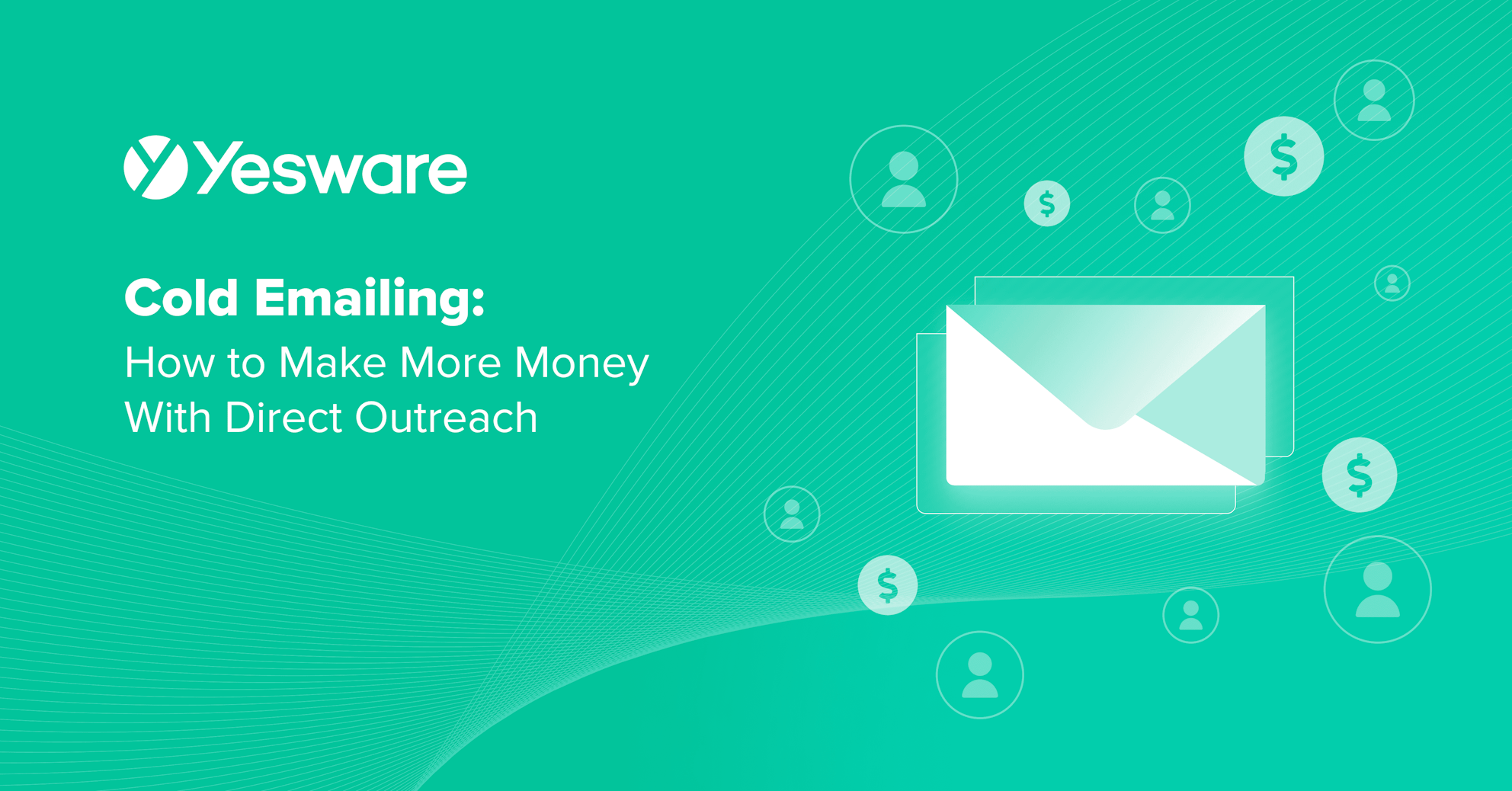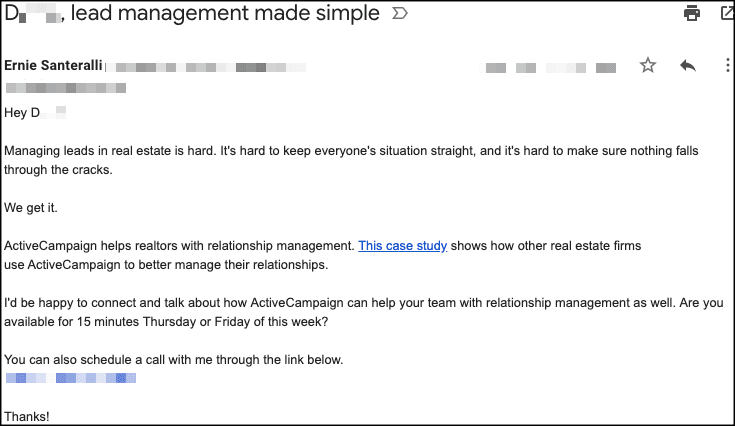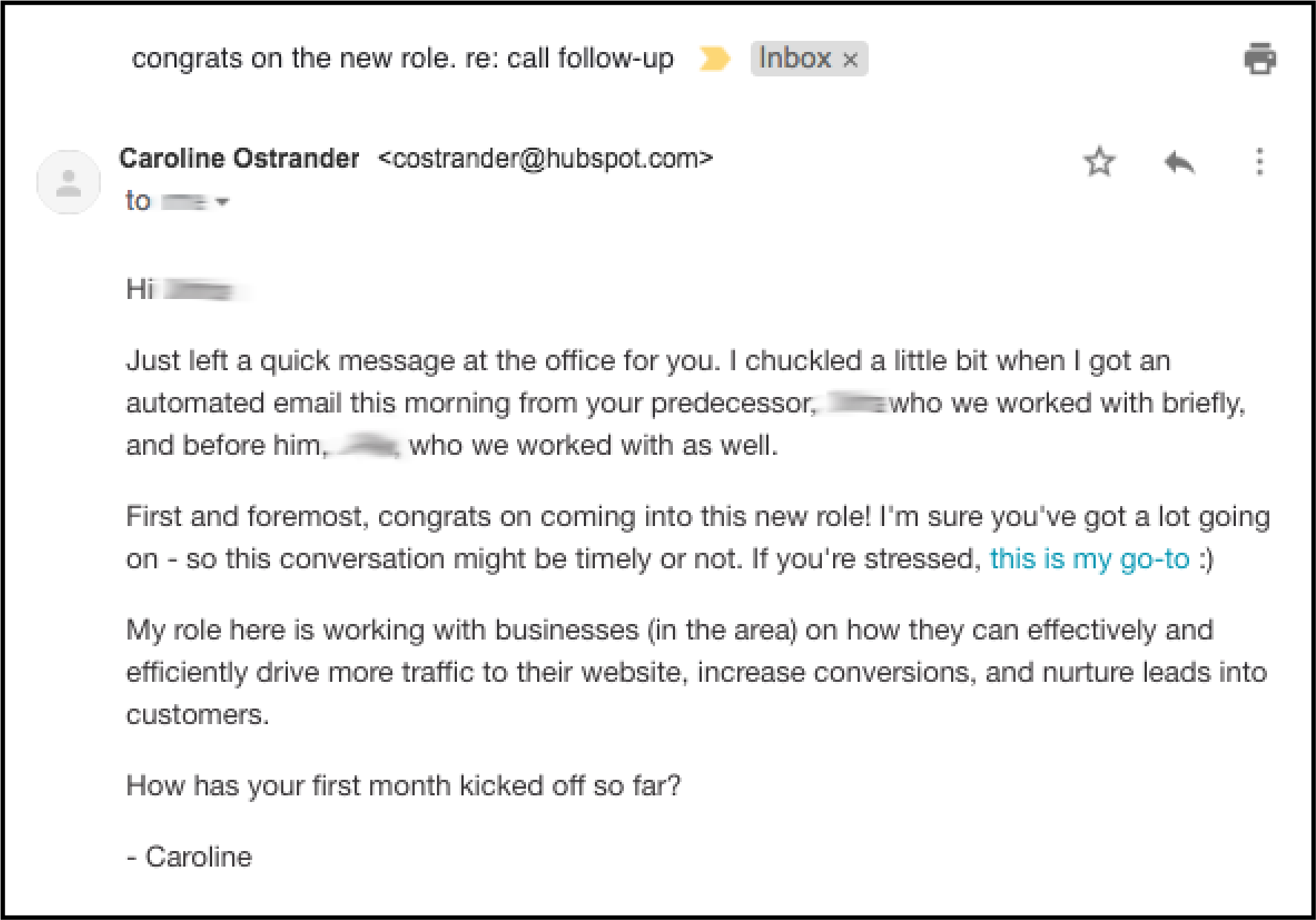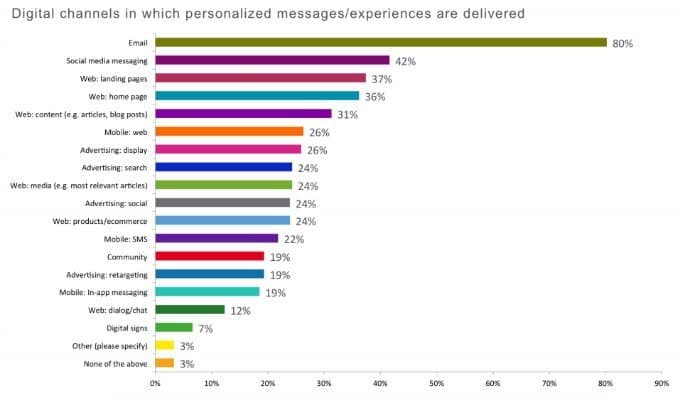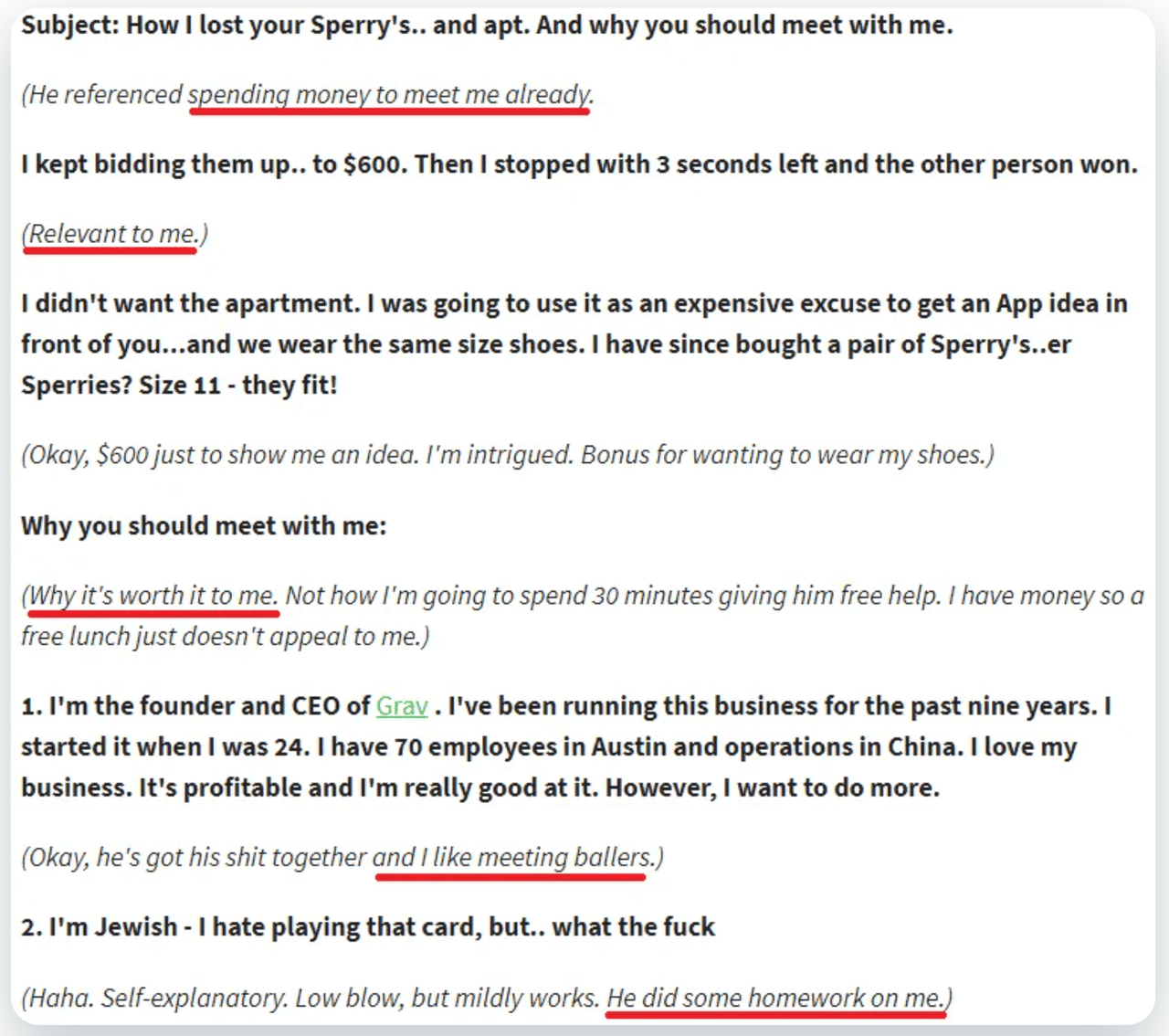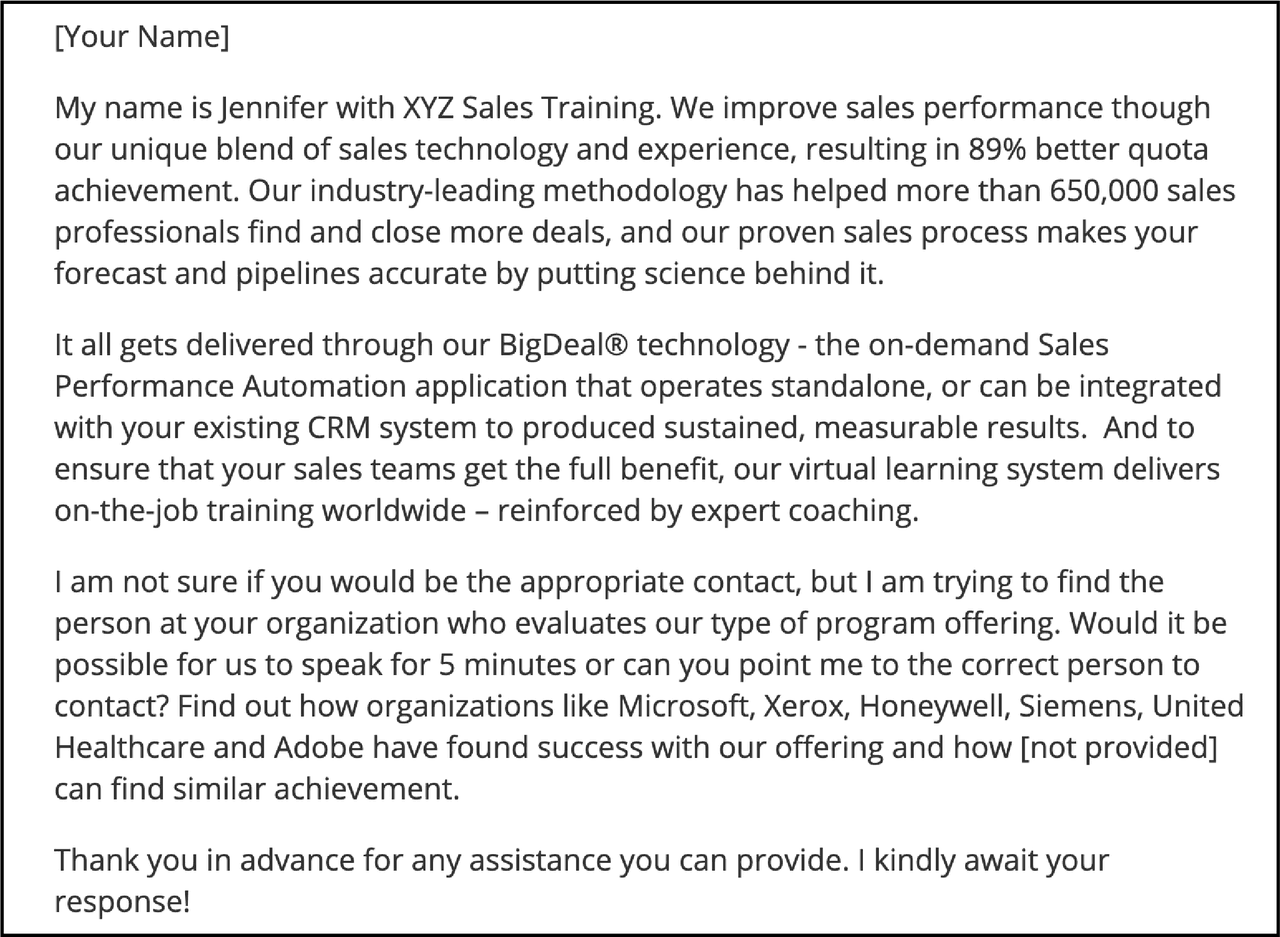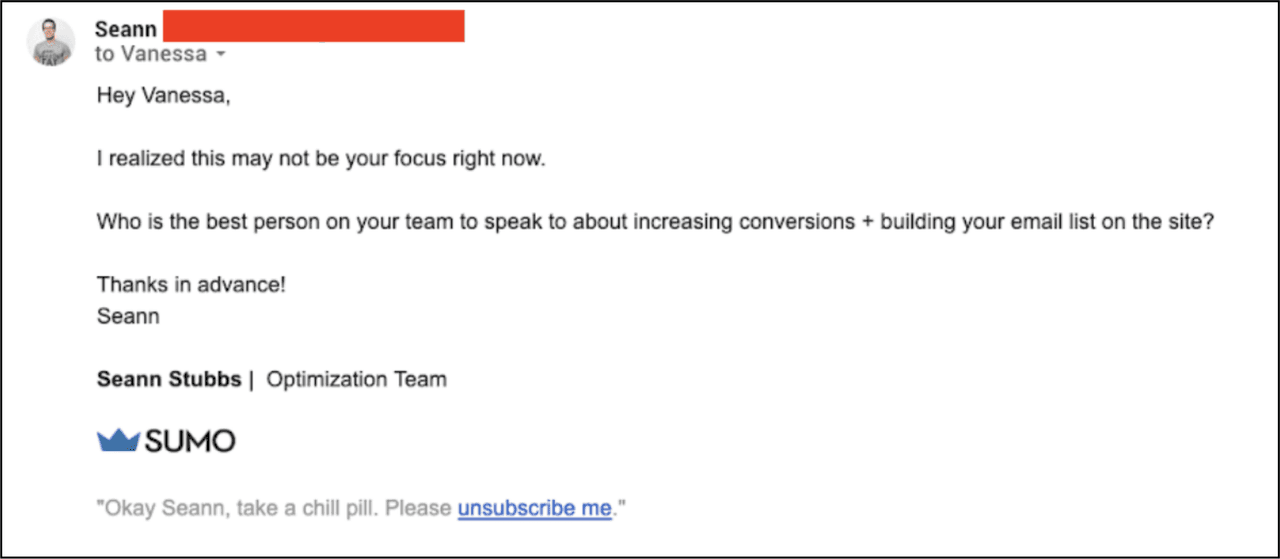Cold Emailing: How to Make More Money With Direct Outreach
Yesware
Cold email is an incredibly powerful sales channel.
… when it’s done right, that is.
The truth is, most people don’t do it effectively.
In this article, we’ll walk through everything you need to know to master cold email.
- Crafting an irresistible subject line
- Personalizing your message
- Crafting a friction-free call-to-action
… and much more.
Let’s get started.
Table of Contents
- Write a Great Subject Line
- Engage Readers With The Opening
- Write Compelling Body Copy
- Close with a Clear Call to Action
- Use Your Signature Wisely
- Sending Out Your Emails
Optimize Like a Conversion Specialist
What is Cold Email?
If you’re in sales, you don’t need to be convinced that cold emails work. Many entrepreneurs have relied on nothing more than cold email to start careers and launch new startups.
Cold email is simple in concept. It’s an email you send to someone that you’ve never met before to start a business relationship.
To be successful with cold email, you need to understand what cold email isn’t.
Cold email isn’t spam. Think about what you do when you get a spam message in your inbox. Delete it, right? And that’s what your prospects will do, too. Today’s prospects expect personalization. Generic, copy-and-paste messages will go straight to the trash.
Cold email isn’t about you. Your prospects have never met you, and they have no reason to care about your amazing product. Focus completely on your readers. Dig into their pain points. And show how you can help solve them.
Cold email isn’t focused on the sale. Most people aren’t ready to buy from a complete stranger. That’s why great cold emails focus on building a business relationship, not asking for a sale. Start the conversation now, and get the conversion later.
Now that you know how to think about cold email, what does it look like in practice?
Glad you asked.
Read More:
- The Death of ‘Spray and Pray’ in Email Campaigns: How to Adopt a More Targeted Approach
- 4 Winning Approaches for Writing a Cold Email
- How to Reignite Your Cold Outreach Strategy During the COVID-19 Crisis
How to Write a Cold Email
When you write a cold email, you should always have a clear, well-defined goal in mind. What’s the action that you want the reader to take?
You might want the reader to schedule a product demo, set up a short initial phone call, or ask you to send over some information.
Knowing the goal is key. Every part of your message should be crafted to engage your reader and pull them along, to the point where they say yes to your offer.
Step 1: Write a Great Subject Line
Think of your subject line as the headline of your message.
It’s the first thing the reader sees. And it determines whether they’ll read further.
Without an engaging subject line, nothing else you do matters. There’s a good chance your subject will click right over your email without even reading it.
Evoke Curiosity
The most important rule to remember with email subject lines is to pique the reader’s interest. Grab their attention, and get them wondering what’s to come in the rest of your message.
Check out how Ryan Robinson builds curiosity by hinting at the possibility of a feature:
Give your prospect just enough to engage their attention, and they won’t be able to help clicking right into your message. Curiosity makes your cold email subject lines irresistible.
Convey a Clear Benefit
One of the best strategies for capturing reader attention is clearly communicating what the reader will get out of your message.
Think about your own email habits. If a message seems relevant to you and your problems, chances are you’ll open it. If not… well, probably not.
When you get it right, a clear benefit is hard for readers to resist.
Read your subject line objectively — and be honest with yourself.
Have you communicated a benefit to the reader? Is it clear what they’ll get out of your message? Would you click on a message with this subject?
If the answer is no, head back to the drawing board.
Go Short (or Go Long)
It turns out that one of the most powerful variables affecting open rate is subject line length.
Cold outreach guru Alex Berman advises sending messages with extremely short subject lines, since they effectively stimulate your reader’s curiosity.
Some high-performing email subject lines that Berman suggests include:
- [your company] + [prospect’s company]
- Idea for [company]
- Hi from [your name]
But longer subject lines can work well. In his study of 12 million outreach emails, Brian Dean found that subjects between 36 and 50 characters tended to get the highest open rates.
These subject lines allowed senders to provide additional context for the content of the email, so readers know what to expect. Examples include:
- Happy with [tool name], [first name]?
- X steps to improving [issue the prospect cares about]
- I can improve your [business metric] by [amount]
Getting your subject line right will get your reader into your message. But that’s only the beginning.
Read More:
- 20 Cold Email Subject Lines Proven to Get Over 85% Open Rates
- Email Subject Lines: 10 Data-Backed Ways to Get More Opens
- The Best Email Subject Lines (+ Ones We’re All Sick And Tired Of)
- How to Start an Email: 3 Lessons Learned from 115,000,000 Emails
Step 2: Engage Your Reader With The Opening
Now that you’ve got a great subject line, you need to keep your readers hooked. And that means a great opening.
Far too many salespeople kick off cold emails by talking about themselves right from the jump. Unfortunately, that’s not relevant to your prospect or their problems. And it’s a sure path to the trash folder.
To make matters worse, most email programs today display the opening line in the inbox. If you start off talking all about yourself, your prospect may not even bother opening your message.
Remember, you’re starting a conversation.
If you were meeting your prospect in person, you’d try to make a connection to start the conversation. In an effective cold email introduction, you’re doing exactly that.
Hubspot’s Caroline Ostrander builds a connection and establishes her familiarity with the target company, right from the jump:
Fortunately, it’s easy to build new connections, even with complete strangers. The key is background research.
Look at their posts on LinkedIn and other social platforms, recent guest posts, interviews, and other media appearances.
Start off your message by complimenting something specific about a recent piece of content. It’s a great way to make a connection — and show that you’re informed about what your prospect is up to.
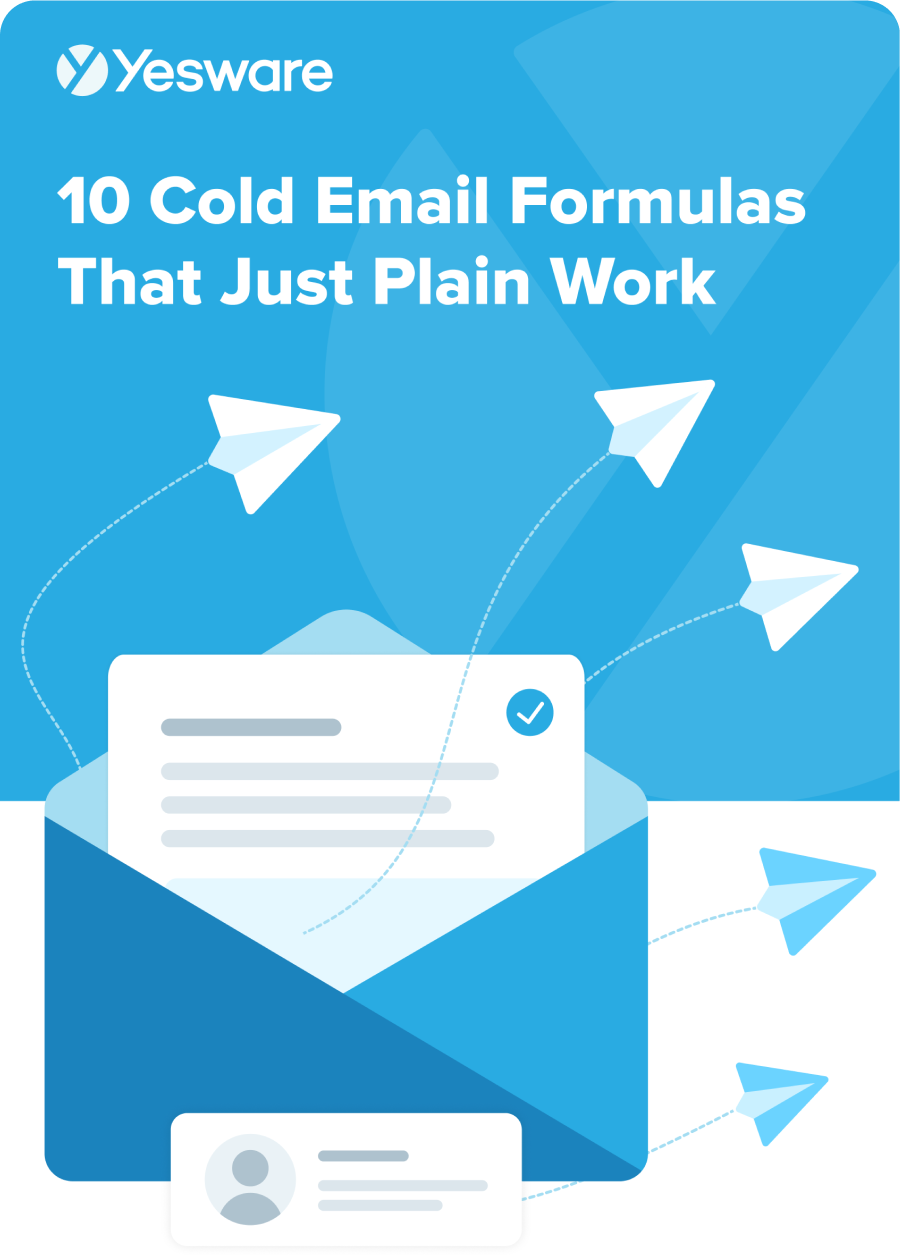 10 Cold Email Formulas That Just Plain WorkSee how B2B sales professionals are using these cold email templates to engage more prospects, fill the top of their funnel and build more sales pipeline faster.
10 Cold Email Formulas That Just Plain WorkSee how B2B sales professionals are using these cold email templates to engage more prospects, fill the top of their funnel and build more sales pipeline faster.
Read More:
- How to Introduce Yourself in an Email the Right Way
- Email Greetings: 10 Ways to Start Your Message Professionally
- Press Send With Confidence: 6 Key Elements of the Perfect Email Format
Step 3: Write Compelling Body Copy
At the end of the day, your message has one job: to get your reader to say yes.
If only it were that easy.
To write cold emails that get responses, you’ll need to check a lot of boxes. Let’s take a closer look.
Shorter Is Better
Decision-makers at large B2B sales companies have busy schedules — and overflowing inboxes.
The last thing they want to do is read a long-winded message from someone they’ve never met.
Long emails can deliver impressive results if they’re thoughtful and personalized. But on the whole, short emails that request a clear, specific action have a much higher response rate.
Don’t go overboard. Three to five sentences is the sweet spot. Make it personal, and provide just enough information for your reader to take the next step.
Make It Personal
Personalization is the single, make-or-break factor that sets successful cold email outreach apart.
When you personalize your message, you move beyond treating your recipient as a prospect and treat them as a real person, someone who could become a valued business partner. You demonstrate that you’ve taken time to learn about them and understand their problems, challenges, and interests.
Most people don’t do this. But for those who do, the work pays off handsomely.
- 92% of marketers say prospects and customers expect a personalized experience in 2020 — up from 85% in 2019.
- Experian found that personalized emails had open rates 26 percent higher than emails without any personalization.
- A study by AWeber found that personalizing subject lines boosted click-through rates by 17.4%, compared with subject lines without any personalization.
- Customer.io reports that personalized emails have 29 percent higher reply rates and 41 percent higher click-through rates, compared with emails without any personalization.
These stats paint a clear picture. In-the-know marketers have been turning to email personalization for years. Sending a generic, slapdash email reflects negatively on you, making you look completely indifferent to your prospect’s needs.
Yesware Templates make it easy to create effective cold email templates with custom personalization touches. Name, location, and job-related information are a great starting point:
Email templates empower you to personalize your messages more deeply, so that your prospect feels that you understand their problems and challenges right away when they read your message.
Try inserting fields into the email body where you can speak to specific pain points you’ve noticed, or ask questions about where your prospect might be struggling.
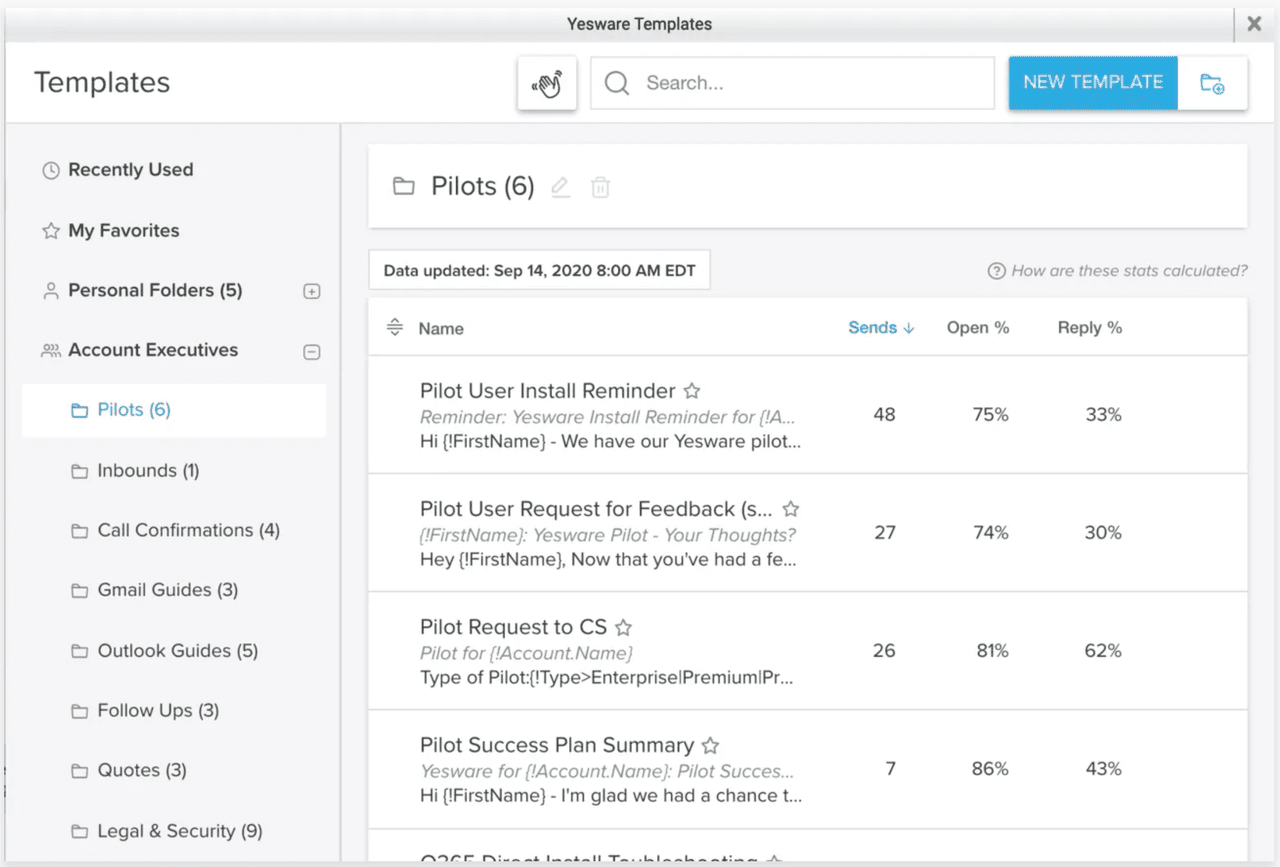
With this approach, you can send customized outreach emails without writing each message completely from scratch.
Email personalization is fun. But don’t go overboard.
After you’ve added personalization elements into your template, give it a quick read-through to make sure it sounds friendly, natural, and approachable. The last thing you want to do is come off as creepy.
Read More:
Speak to Your Reader’s Challenges
So personalization is great — but how do you know what to say?
That’s where research comes in.
Your pitch should be completely centered on your prospects.
- Focus on pain points uncovered in your research to demonstrate that you understand your reader’s problems.
- Tell stories and share examples of how you’ve helped customers with similar challenges in the past.
- Use future pacing to help your prospects envision how your solution could transform their life.
As cold outreach ninja Bree Weber points out, knowing everything you can about your prospects’ challenges is the key to a highly personalized cold email that stands out:
Research allows you to collect voice-of-customer data, discover your prospect’s pain points and identify their goals. When you can pull all this data into your cold email, you’re actually weaving in incredibly persuasive tools like specificity and relevancy. And those tools can make the difference between a conversion and the delete button.
Fortunately for you, there’s plenty of information on your prospects’ priorities, hidden in plain sight. You just need to know where to look.
Here’s where Bree suggests starting your search:
My favorite source for learning about a company’s objectives is in stories. Some of the places I’ll go to look for company stories include:
- articles where the prospect talks about their goals
- company-produced content like webinars where they tease out what’s coming next
- podcast episodes where the founder talks about past challenges
Stories are some of the best places to tease out that voice-of-customer that makes a pitch so effective.
Finally, remember the power of loss aversion. People are much more motivated to avoid losses than to get equivalent gains. If you’ve uncovered a major pain point that you can help your prospect avoid, be sure to highlight and dig into that in your message.
Offer Social Proof
Most of the time, our decisions are made under conditions of uncertainty. And that’s absolutely the case with cold email.
After all, your prospect is essentially trying to decide, “should I respond to this message from a person I’ve never heard of before?”
And the best way to make that decision less risky is to offer social proof.
With social proof, we look to the choices others have made to guide our own decisions. It’s a phenomenon that plays an extremely powerful role in our everyday decision-making.
Here are two ways to do it.
Results. Be sure to mention any well-known clients or outstanding results that would impress your cold outreach targets. In the context of a cold email, this isn’t bravado. You’re setting yourself apart from the amateurs who are flooding your prospects’ inboxes by showing that you’re an experienced pro who can deliver on what you’re promising.
One of the most famous cold email examples shows how it’s done. Dave Daily’s pitch to Noah Kagan is a masterclass in quickly establishing authority in order to get a response from a decision-maker:
Mutual connections. Without a doubt, the most powerful form of social proof you can offer is a mutual connection. When you know someone in common doesn’t just give you social proof — it’s also an instant starting point for conversation.
If a personal friend knows your prospect, it can help you stand out — but won’t necessarily demonstrate your expertise. It’s best to mention this type of connection in the opening to your message.
On the other hand, if your mutual acquaintance is a business connection, they can likely speak to your ability to deliver results. These connections are great to mention in the body of your message.
Talk Like A Real Person
How you write is as important as what you write. And the best way to engage your reader is to write conversationally, just like you’d talk.
In other words, avoid this kind of trainwreck:
Nobody would ever try to strike up a conversation with: I’m with XYZ Sales Training. We improve sales performance through our unique blend of sales technology and experience.
And if they did, the conversation probably wouldn’t last long.
Start with a mutual point of connection, just like you’d do in person. And maintain a friendly, approachable tone throughout your message.
When you’re done writing, take time to read through your message. By doing this, you’ll identify points that don’t sound natural, so you can take a few minutes to rewrite them.
Create Custom Content
Think outside the box. And as more and more sales pros dial-up their personalization, looking for creative ways to go beyond your email body text can help you stand out.
Sending along sales collateral or any piece of content custom-created for your recipient is a great way to grab your reader’s attention.
Kyle Racki at Proposify shares the example of a stellar cold email he received from FullStory that included a quick, relevant product demo:
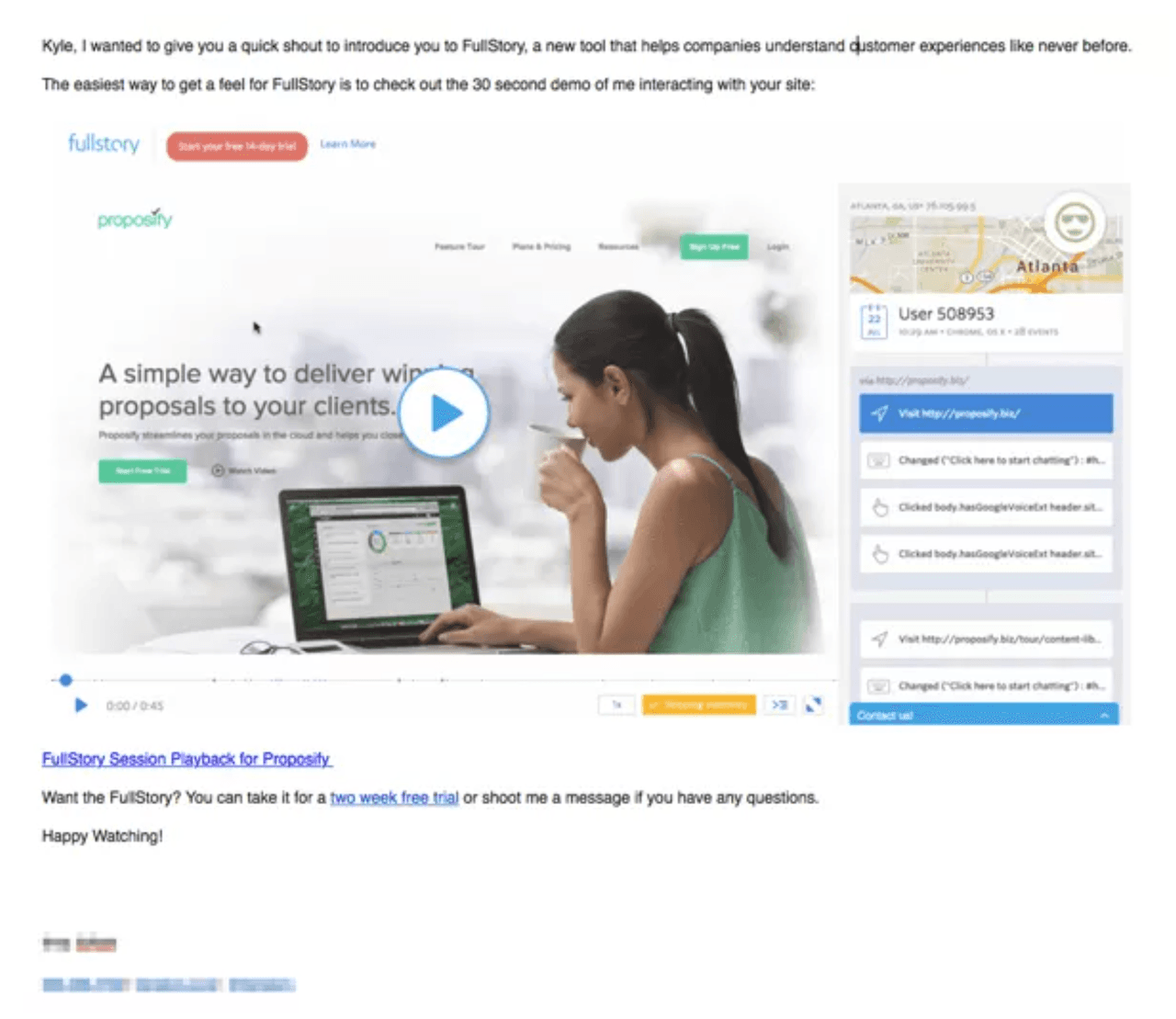
As Kyle notes, this email shows you don’t have to do a ton of work to show you understand your prospect:
“In just a few more characters than a Tweet, Trey shows that he knows what I care about. Proposify is a SaaS company. We care about delivering great experiences to our customers, and understanding those experiences is top-of-mind for me. OK, I’m interested.”
Use Proven Copywriting Formulas
When you write a cold email to a prospect, you are a copywriter. Copywriters write words that are designed to elicit action.
So it’s no accident that we’ve encountered key principles of good copywriting again and again throughout this article.
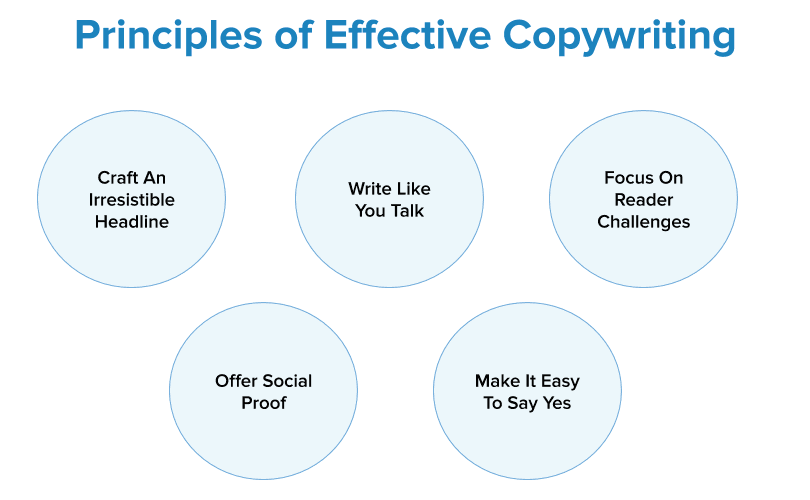
But pro copywriters don’t reinvent the wheel every time they sit down at the keyboard.
They start with proven formulas in mind. These mental heuristics help them accelerate their writing and increase their output.
Here are a few formulas you can start using today.
AIDA: Attention, Interest, Desire, Action
Attention: Seize the reader’s attention
Interest: Provide new, unusual or surprising information to grab their interest
Desire: Engage the reader’s emotion so they want what you’re offering
Action: Ask them to take the next step
Here’s AIDA in action:
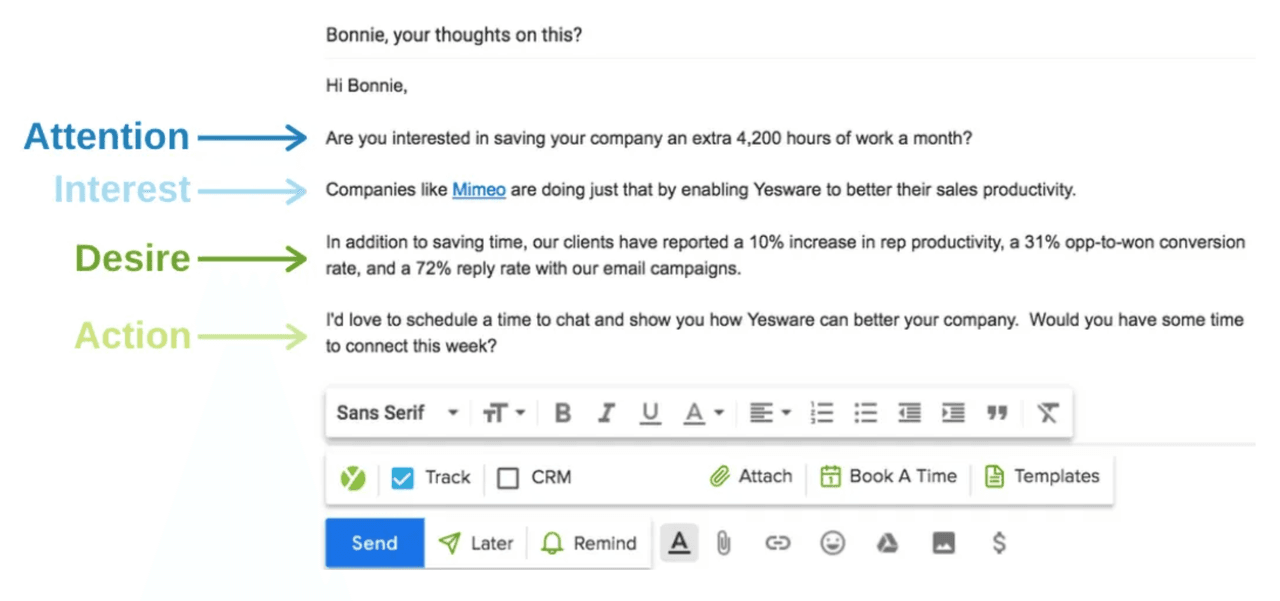
It’s easy to see how the prospect of saving thousands of hours of work would grab the reader’s attention. But where this email really shines is building desire. By sharing lots of concrete data, the message provokes a sense of FOMO — and leaves the reader wanting the same great productivity gains other sales teams are getting.
PAS: Problem, Agitate, Solve
Problem: Focus the reader’s attention on a pain point
Agitate: Poke at the pain point until it’s as real and visceral as possible
Solve: Show how your offer can resolve the pain point
Here’s what PAS looks like:
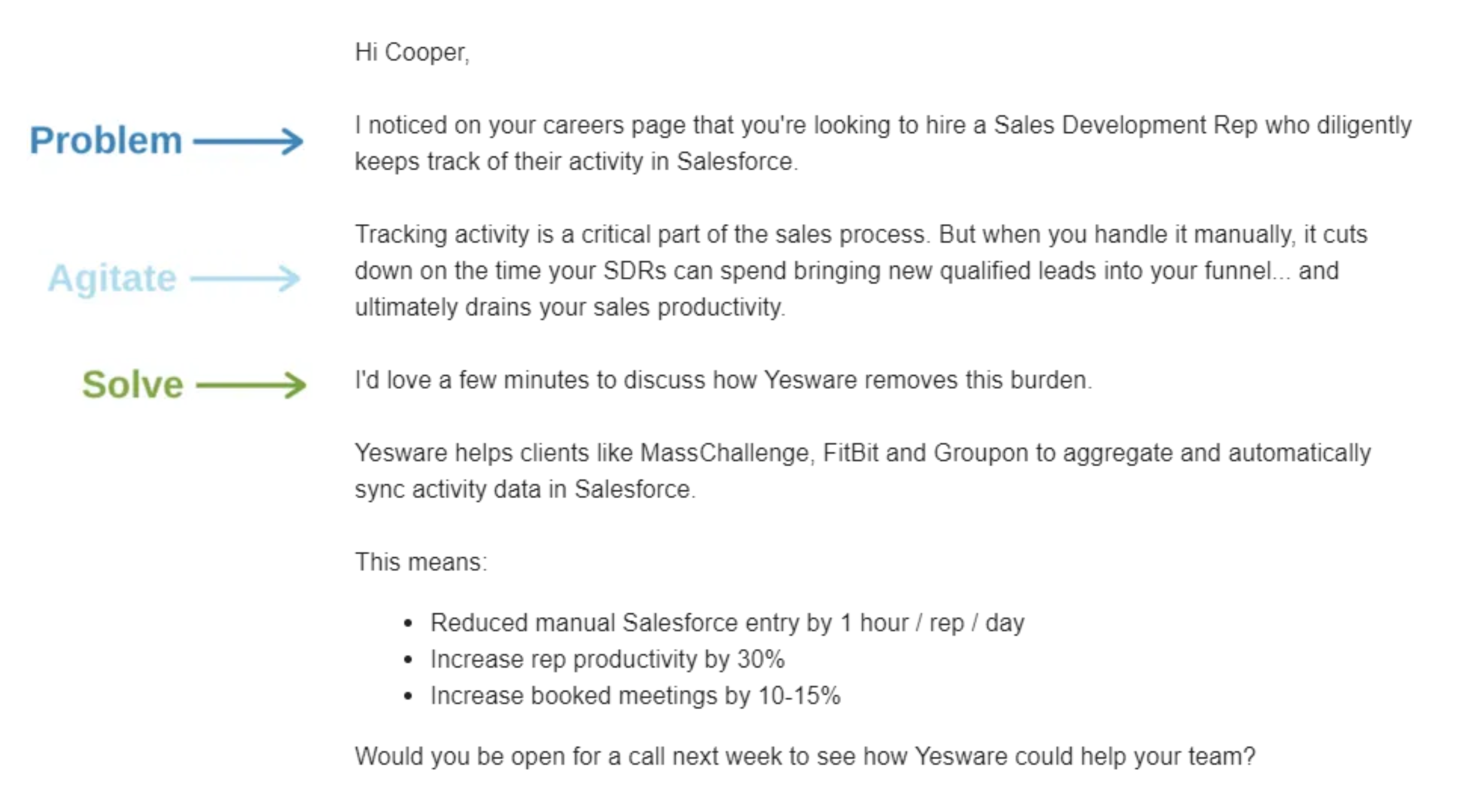
The real strength of this message is the agitation section. Instead of just highlighting a problem, the writer drills down by pointing to specific, concrete pains that the problem is causing. By the time the reader gets to the solution, taking the next step sounds like a no-brainer.
BAB: Before After Bridge
Before: Paint a picture of the reader’s life now
After: Help the reader imagine how their life could be in the future
Bridge: Show how your offer is the path to the imagined future
Here’s how it’s done:
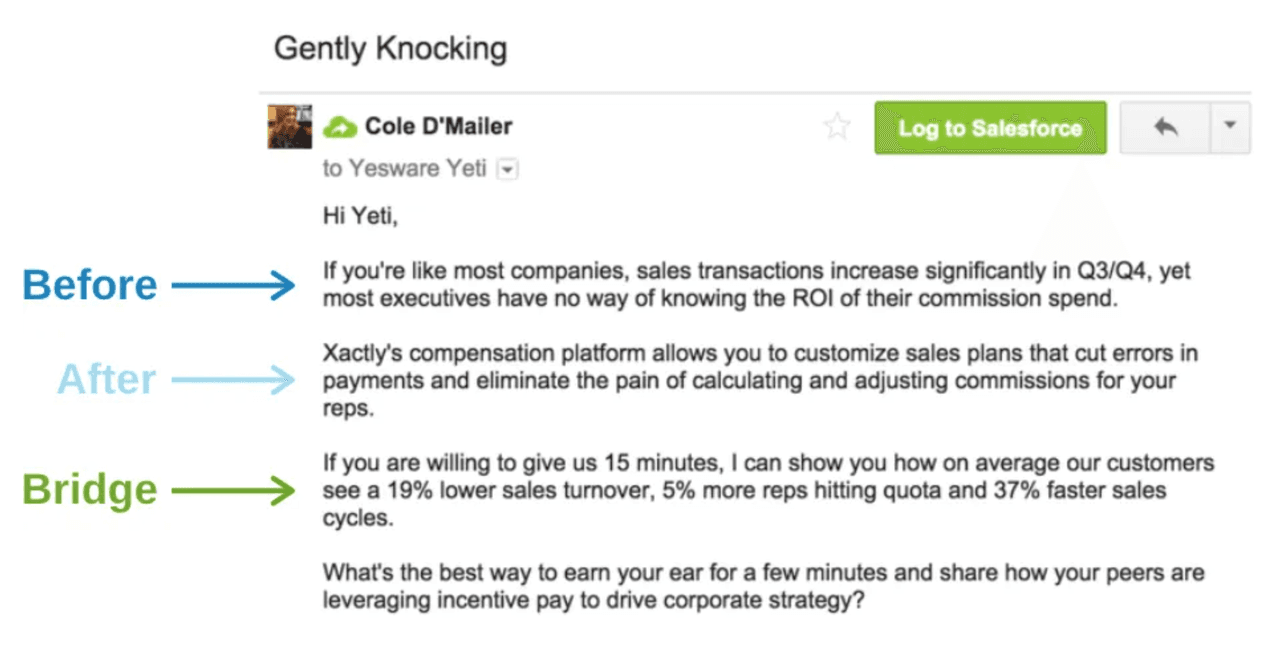
In this message, the writer paints a picture of how the reader’s business could be transformed using Xactly, then shows that he’s offering a bridge to that imagined future.
PPP: Praise, Picture, Push
Praise: Open with a sincere, respectful compliment
Picture: Paint a picture of everything the prospect could do with your solution
Push: Invite your prospect to take action
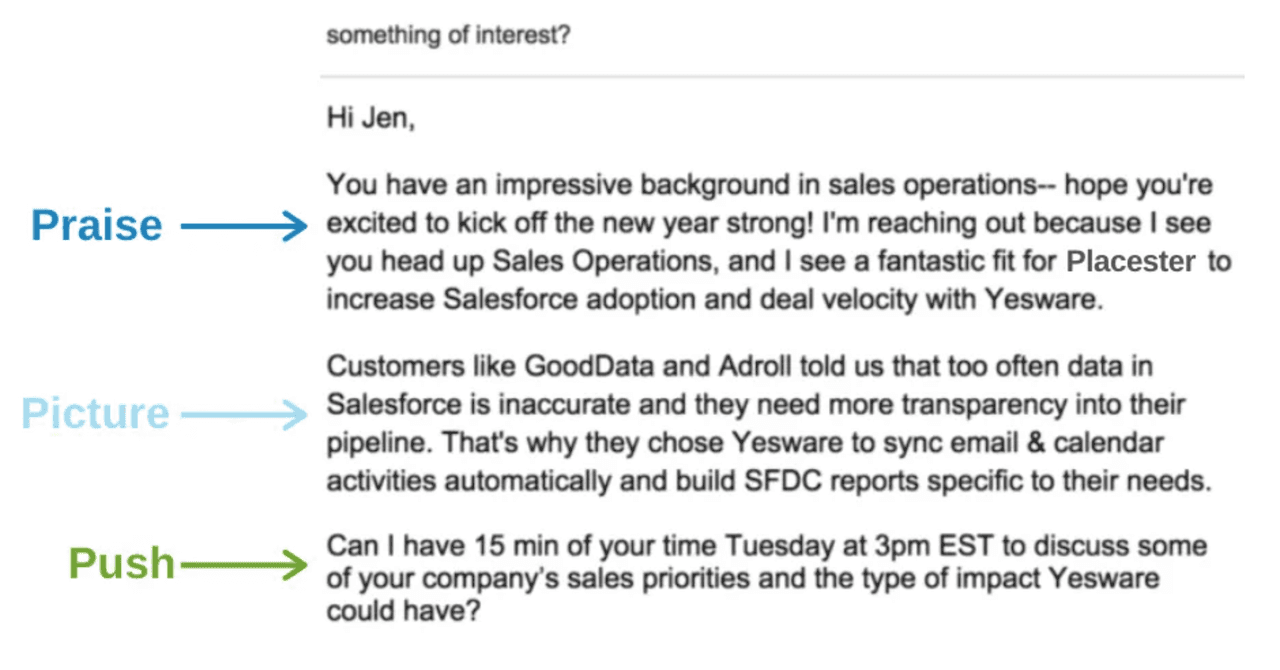
The strength of this message is the opening. Leading with a specific, meaningful compliment increases the chances the prospect will keep reading as the sender discusses their solution and makes their ask.
Of course, copywriting formulas like these are guidelines, not rigid rules. You can modify or add to them as you like. Focus on guiding your reader toward saying yes to your offer, and you won’t go wrong.
Read More:
- 10 Persuasive Techniques That Are Extremely Easy (And Effective)
- How To Write a Pitch That Converts Prospects
- The Best Sales Pitch Examples: Our Top 11
Step 4: Close with a Clear Call to Action
You’ve written a magnetic subject line. Wrote an irresistible opener. Crafted an engaging message.
Now it’s time to make the ask.
Writing a strong call to action is pretty simple. You just need to remember three basic rules.
Focus on the Relationship
Generally speaking, the first email is the start of a business relationship. Unless you have a very modestly priced offer that you can expect prospects to say yes to right away, the first email isn’t the place to ask for the sale.
Instead, focus on building trust and establishing a business relationship. You’ll want to gradually nurture your prospect into a long-term business partner.
Craft a Crystal-Clear CTA
The entire purpose of a cold email is to prompt your prospect to take an action.
And that means if your message doesn’t close with a clear ask, the chances of a positive response are dramatically diminished.
You’re asking for your prospect’s time and attention — and that means it’s on you to give clear, specific directions for what to do next.
Avoid vague, hesitant endings like these:
- Let me know what you think.
- Hope to speak with you soon!
- Look forward to hearing from you.
Ending your email this way can undermine all your email outreach efforts.
You’re putting an added burden on the recipient by leaving it up to them to decide on the next step. And for a busy decision-maker at a large company, the next step will most often be none at all.
Make It Easy To Say Yes
Knowing that the email recipient is likely a high-level decision-maker, you’ll want to craft a CTA that’s easy for them to say yes to.
Be very specific about what you’re asking. And make a request that moves your relationship forward — without requiring a sacrifice of time or effort from your recipient.
Consider low-friction CTAs like these:
- Can I send over a quick video?
- Mind if I send over some info?
- Are you available for a 10-minute call next week?
- Is improving your sales productivity something you’re focused on for 2021?
Read More:
Step 5: Use Your Signature Wisely
Once you’ve finished your CTA, you might think you’re done. But we’re not ready to hit send just yet.
Your email signature is a critical part of your email.
You’ve been painting a picture throughout your whole message: that you’re a customer-centered pro who thinks proactively and can help your reader solve their most urgent challenges.
And your signature can either reinforce that message — or undercut it entirely.
The truth is, your reader shouldn’t pay much attention to your signature. It should sit there at the bottom of your email, subtly reinforcing that you’re a trustworthy expert.

Adding relevant links is helpful, but don’t go crazy. Only include what will help move your relationship forward.
There’s no reason not to have a professional signature in 2020. Tools like WiseStamp and MySignature can help you avoid a dumpster fire like this:
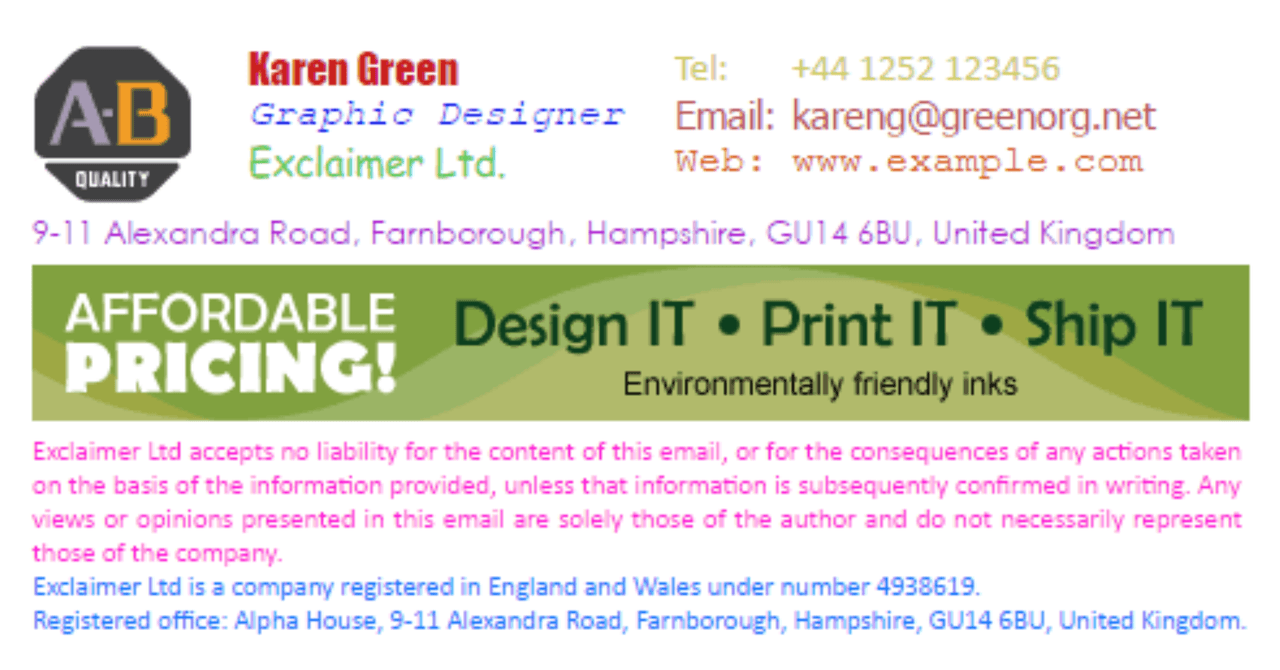
A sloppy signature can kill your reply rate. Even if your open rates are solid, a careless signature is a warning sign to your prospect that you may not be the right person to help them, after all.
Read More:
- 10 Professional Email Signature Examples + Best Signature Generators
- 6 Key Elements of the Perfect Email Format
Step 6: Sending Out Your Emails
When you’ve really nailed your cold email, you don’t want to send it once. You’ll want to use it again and again.
The key is turning your cold email into a template, using fields that let you add personal touches to every message.
To make it happen, you need a tool built for sending outreach at scale like Yesware Campaigns.
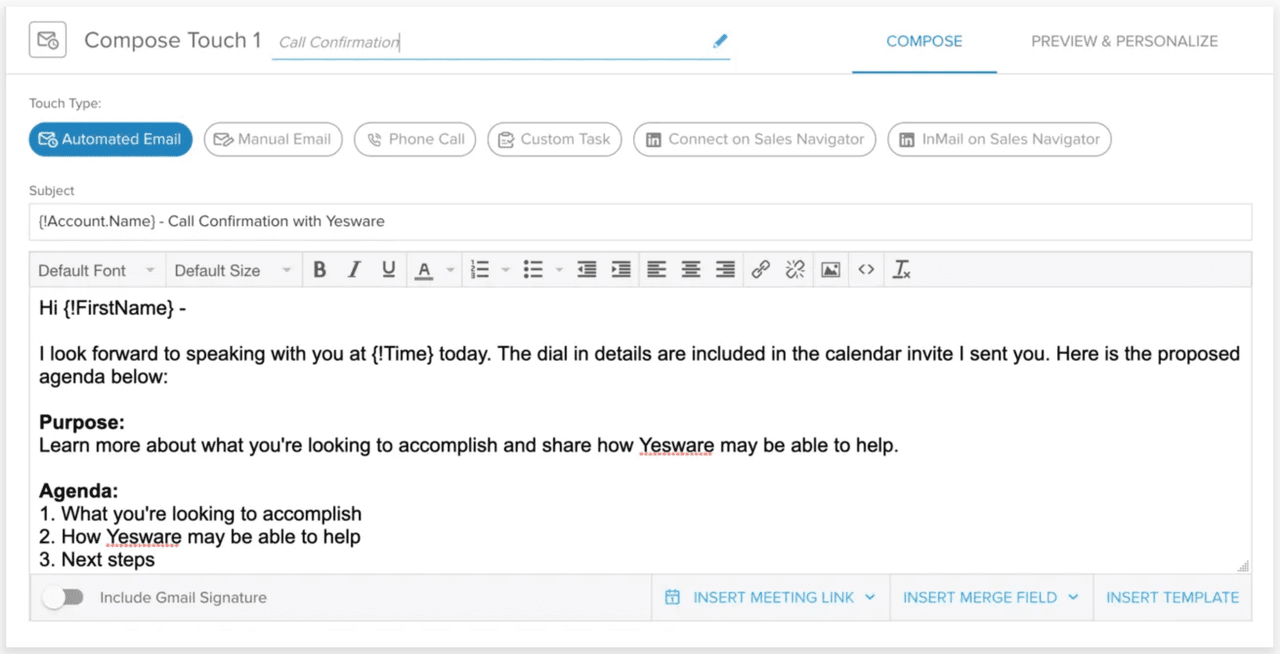
With Yesware Campaigns, you can easily add personalization elements to your cold email template, enabling you to rapidly send relevant, targeted messages to dozens of prospects.
It’s the easiest way to leave spray-and-pray behind, and connect with your ideal customers on a personal level.
Optimize Like a Conversion Specialist
Conversion specialists optimize a company’s digital marketing efforts to get the best conversion rates possible. As you start sending more emails, it’s time to adopt the mindset of a conversion specialist. Take a step back and look for ways to improve your results.
When you optimize emails, there are two fundamental questions to ask: “Are my emails getting opened?” and “Are they being read?”
Outreach tools that help you track email performance, like Yesware Reporting, can help you see your greatest opportunities for improvement.
For cold email campaigns, the most important metrics are open rate, reply rate, meeting book rate, and bounce rate.
Knowing industry standards for these stats can help you set reasonable targets.But in practice, making incremental improvements is the best path to success. For example, if your open rate currently stands at 45%, you might aim to get it up to 50%.
Improving Open Rates
The average open rate for a personalized campaign is 47%. If your open rate is low, then too many prospects aren’t reading your messages.
Here are some key issues to look out for.
Your emails aren’t being delivered. If you have a high bounce rate, your emails aren’t getting to your prospects. Make sure your marketing team is verifying all the leads they share with you using a tool like NeverBounce so they reach your prospect’s inbox.
Your emails are going to spam. Be sure you’re avoiding common mistakes that can get your email flagged as spam.
Your subject line is weak. Once you’ve addressed deliverability issues, the main culprit is the subject line. Try strategies like these to improve your open rate:
- Using shorter (or longer) subject lines
- Including personalization
- Crafting subject lines that build curiosity
Improving Reply Rates
Of course, it’s just as frustrating if your prospects are reading your emails but aren’t replying. Keep things in perspective — the typical reply rate for a personalized campaign is 9%.
Here are some things to look for to improve your reply rates.
You’re focused on you. The fastest way to kill your reply rates is to start talking about yourself right away. Instead, focus on your reader and showing how you can help solve their problems.
Your email is too generic. Copy-paste messages are almost guaranteed to go to the trash. Make sure your messages are relevant. With message templates, you can insert customizable form fields that make it easy to tailor the message to each recipient.
You haven’t included social proof. Your offer might sound great — but if you haven’t given your reader any reason to think you can deliver, there’s little reason to reply.
Your CTA is asking for too much. As we noted earlier, if you’re making a demand of time or effort on the part of your reader, there’s a good chance you won’t get a response — so make your ask as hassle-free as possible.
Read More:
- Top 5 Reasons Your Emails Are Going To Spam
- Improve Sales with Email Tracking — Backed By Data
- How to Stop Fearing and Start Crushing A/B Testing
- Decrease Your Email Bounce Rate With These Best Practices
Always Follow Up
The easiest way to improve the performance of your sales campaigns is surprisingly simple: send more follow-ups.
And the stats prove it.
The first follow-up email in a sales sequence gets a response rate of 21%, on average — and you can send as many as seven follow-ups before the expected response rate drops below 10%.
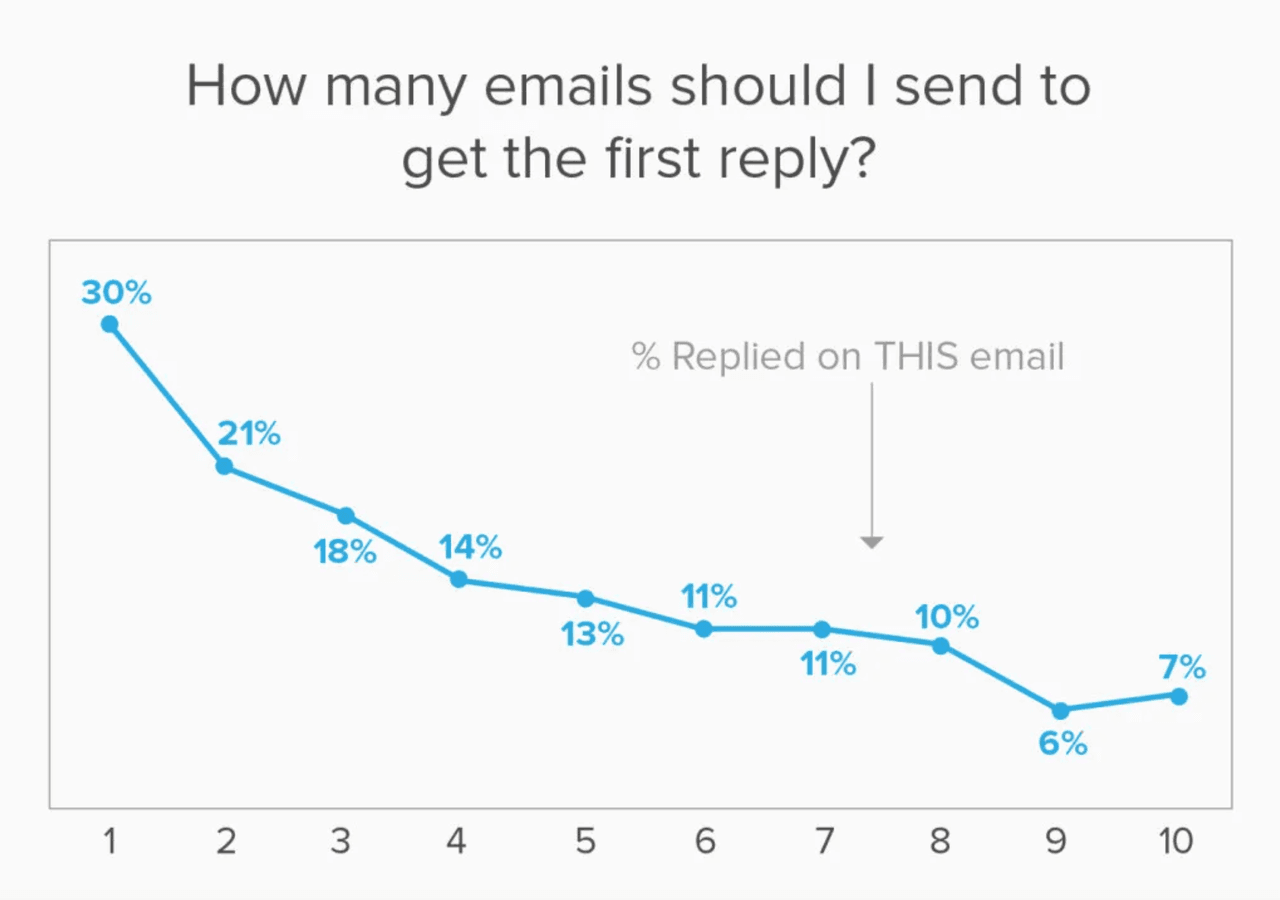
And yet 70% of sales email chains stop after the first outreach, without any follow-up messages at all.
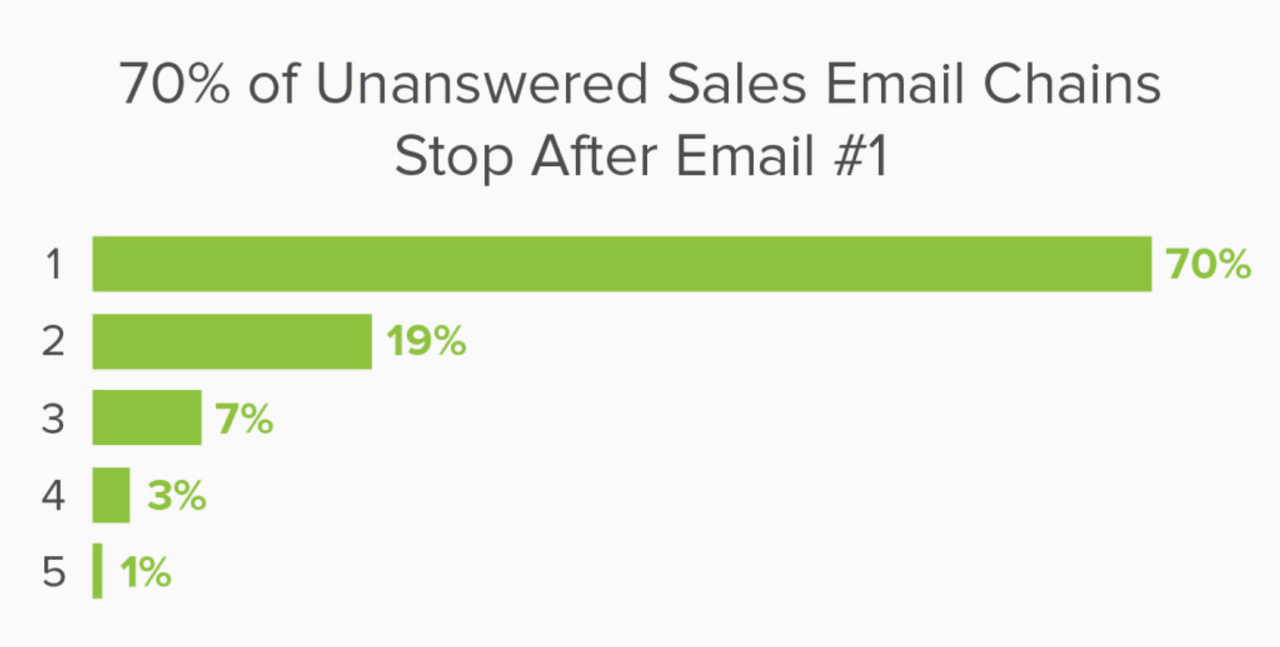
The statistics are clear. If you aren’t sending multiple follow-ups on your sales emails, you’re leaving money on the table.
And that’s where an email outreach tool with automation features like Yesware Campaigns can be a game-changer.
When you’re connecting with dozens of new leads every week, it’s challenging to follow up with all of them in a timely manner.
Yesware Campaigns enable you to send out automated touches that continue to go out until a prospect responds — at which point you can take over.
But what does a solid follow-up look like?
Here are three of our favorites.
Following Up on a Cold Email
Sometimes, your prospects are just busy. Here at Yesware, we’ve found that a simple nudge can be incredibly effective.
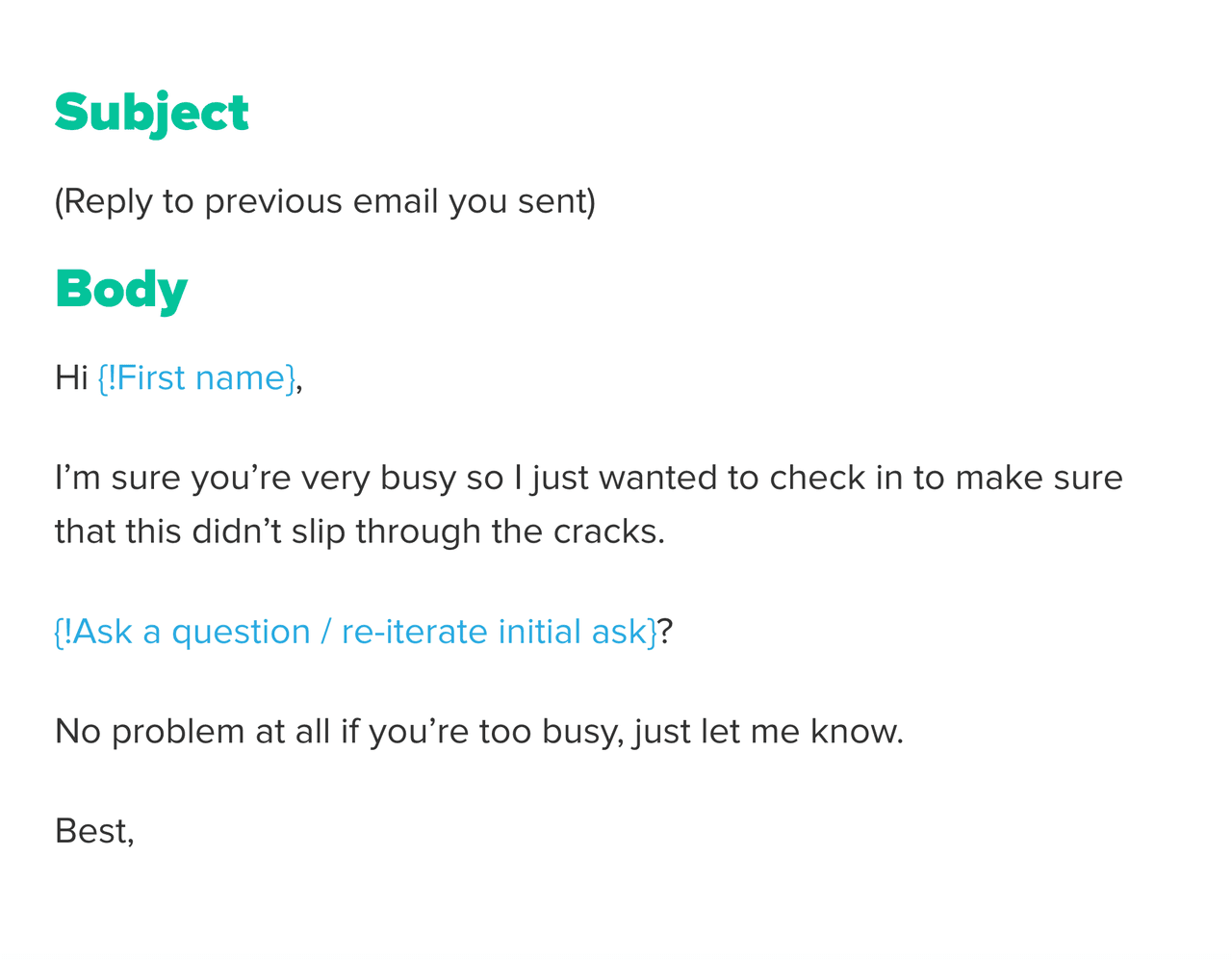
Closing with “no problem at all, just let me know” gives the email a casual, no-pressure vibe that makes your follow-up seem more personal… and easy to respond to.
Finding The Right Contact
Other times, you won’t be reaching out to the right decision-maker. And as the team at Sumo has discovered, often the best move is to pivot to someone who can say yes.
This follow-up is most effective when you’ve sent a couple of outreach emails without a response.
The Break-Up Email
Cold email guru Bryan Kreuzberger relies on the break-up email as one of his staples. It’s perfect for when you haven’t heard back from a prospect after several follow-ups.
This email is especially effective with a subject header like “Permission to close your file?” It works by building a sense of urgency, leading prospects to feel that they’ll miss out on your offer if they don’t take action.
Read More:
- How to Increase Email Engagement: Our Best Practices
- 5 Sales Follow-Up Email Mistakes That Are Costing You Time and Money
- Top Sales Follow-Up Statistics & Tips [2021 Data]
Conclusion
You can dramatically level up your sales outcomes with cold email. The key is to put these principles into practice.
Make cold email a habit. Set a goal for the number of new cold outreach emails you’ll send each day — and stick to it.
Once you’re comfortable, look for ways to improve your cold outreach game. How can you send more personalized messages? How can you improve your follow-up?
Stay consistent. Over time, a strong outreach game will make you an invaluable contributor to your sales team — and build relationships that will elevate your career.
About the Author: Chris Collins is a copywriter and conversion strategist for B2B and SaaS companies. He specializes in research-driven copy and content that helps brands engage visitors and turn them into customers.
Get sales tips and strategies delivered straight to your inbox.
Yesware will help you generate more sales right from your inbox. Try our Outlook add-on or Gmail Chrome extension for free, forever!
Related Articles
Jenny Keohane
Jenny Keohane
Melissa Williams
Sales, deal management, and communication tips for your inbox
